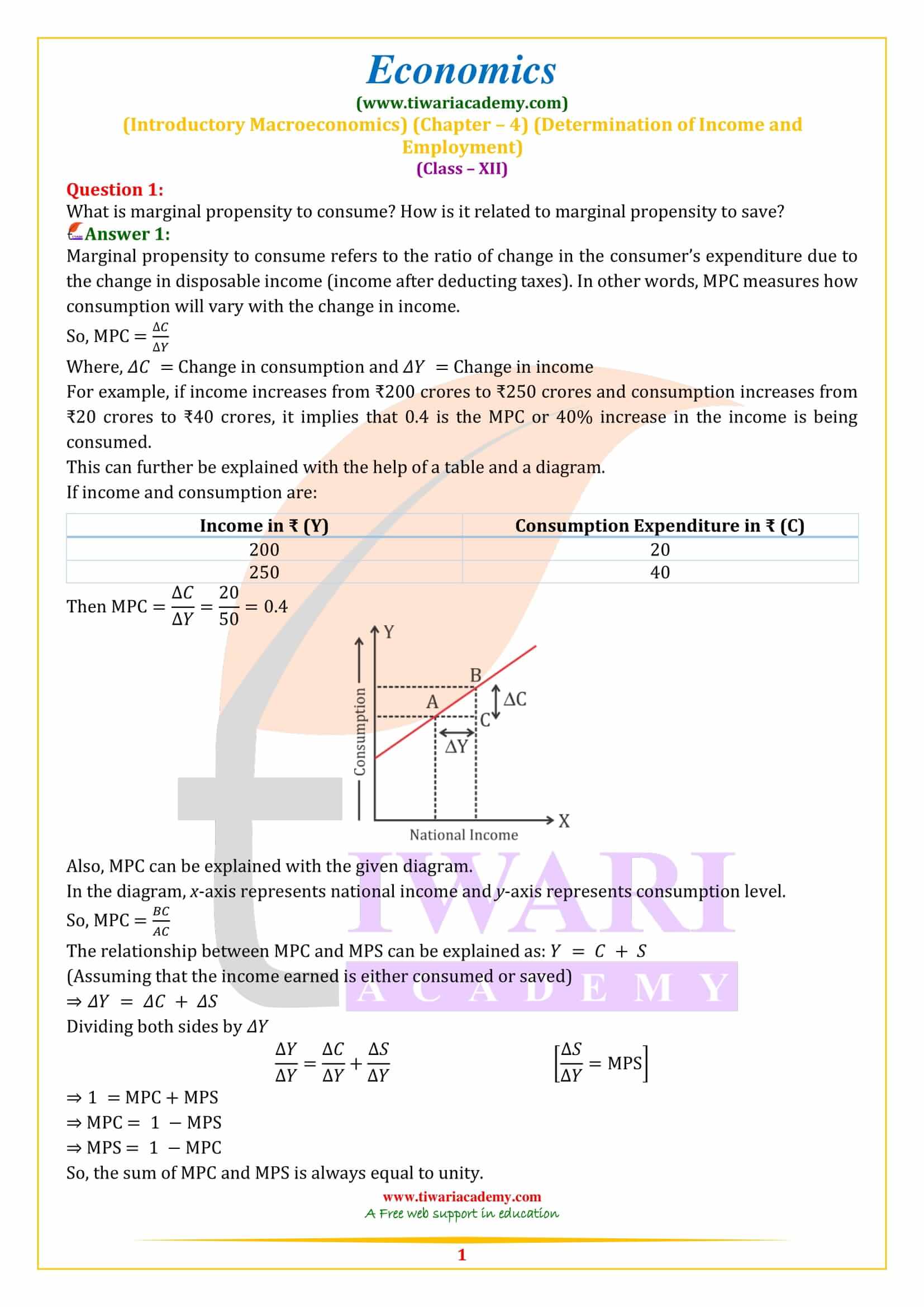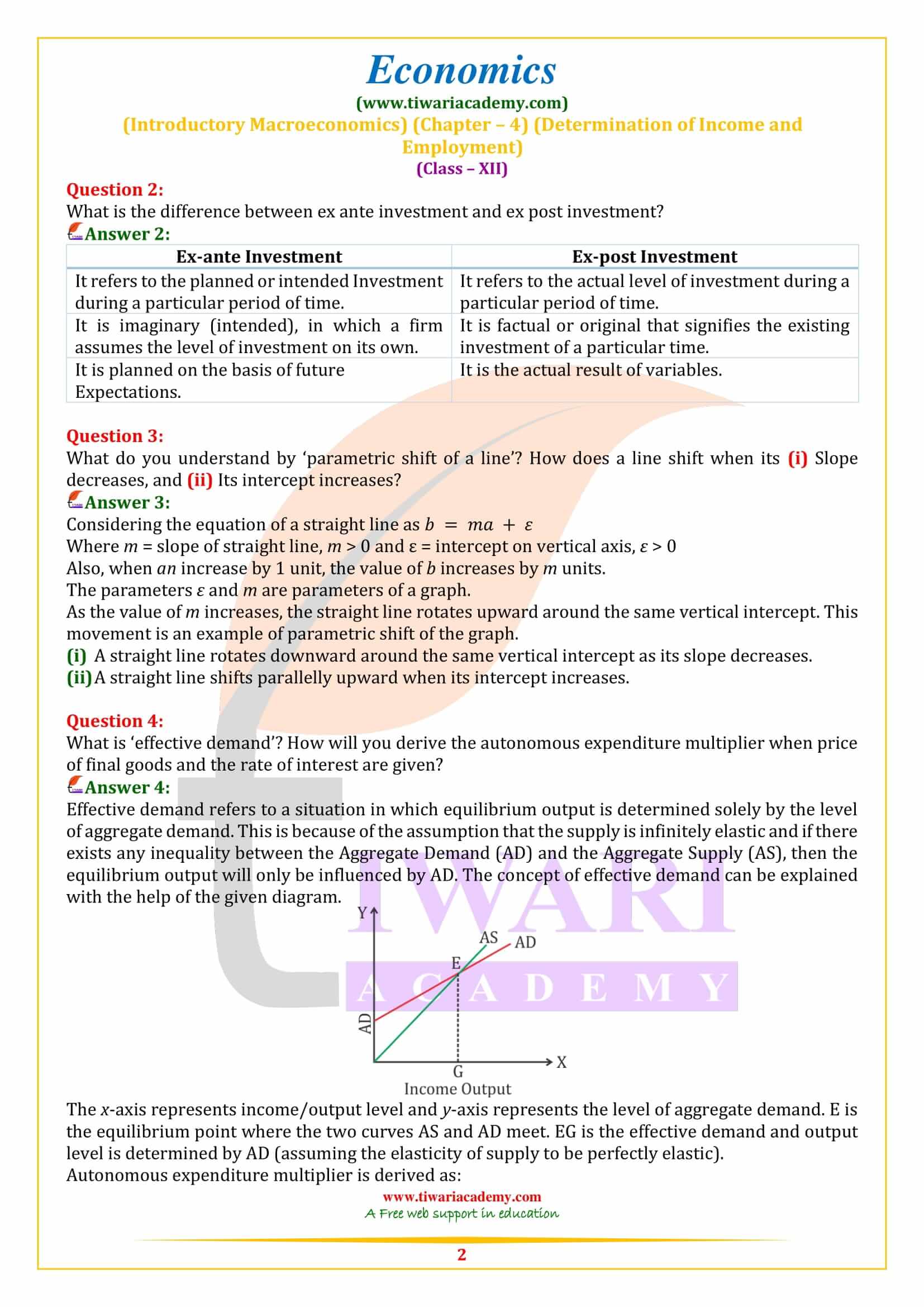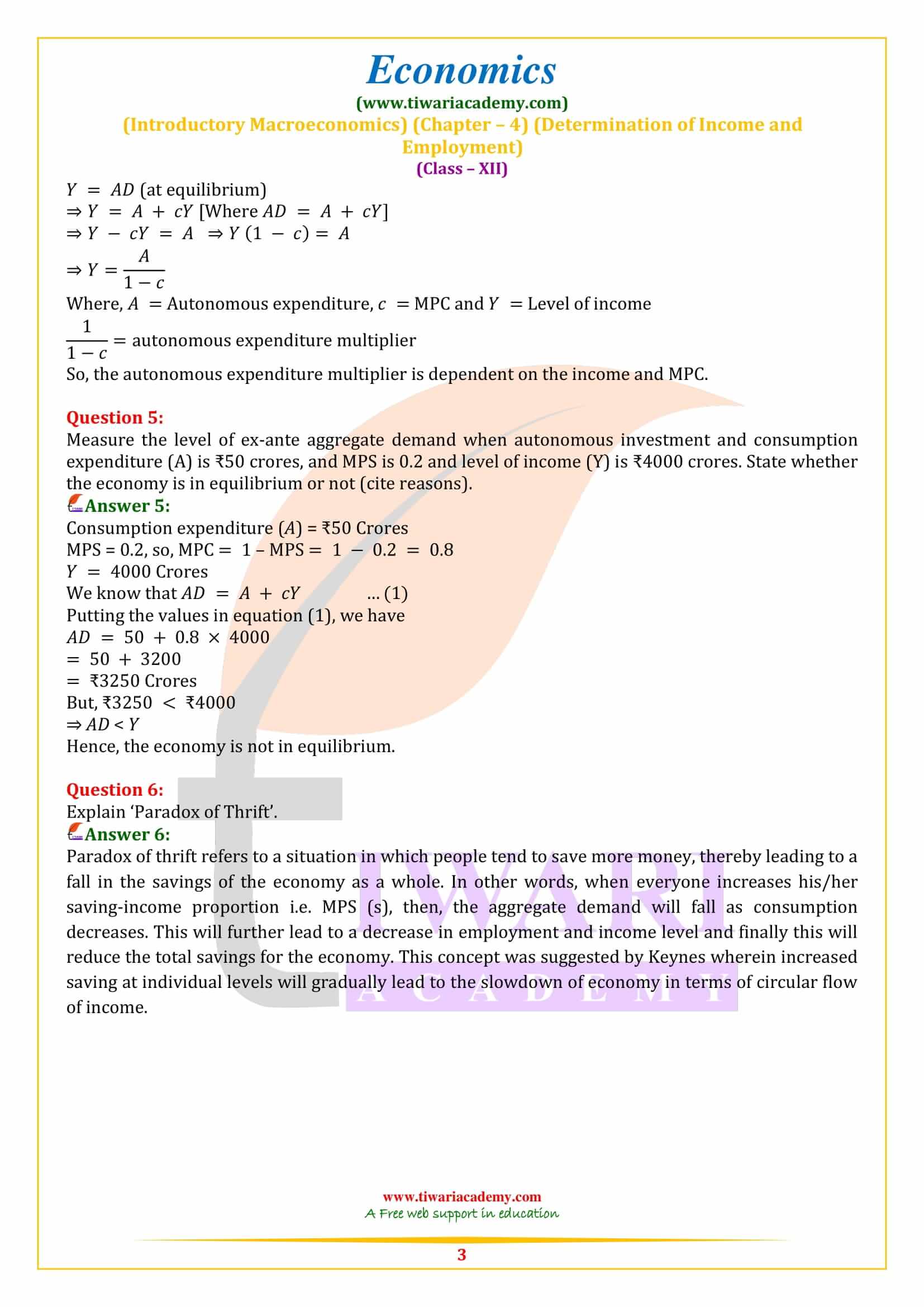NCERT Solutions for Class 12 Economics Chapter 4 Determination of Income and Employment – Macroeconomics prepared for CBSE session 2025-26. Get here class 12 Macroeconomics chapter 4 MCQ Case Studies and Important question answers for the preparation of board exams.
Class 12 Economics Chapter 4 Solutions
Class 12 Macroeconomics Chapter 4 Determination of Income and Employment Question Answers
12th Economics – Consumption and Investment
The most necessary determinant of consumption demand is household income or financial gain. A consumption function describes the relation between consumption and financial gain. The simplest consumption function assumes that consumption changes at a continuing rate as financial gain changes. Suppose a family earns 20 thousand per month. Their consumption during a month is going to be less than or adequate to their earnings. And once the earnings of that family are going to increase with time, their consumption ability will also increase. It may be in terms of purchasing higher product or services than the present ones which they have or purchasing new goods and services.
Like upgrading a mobile phone, a desktop or a laptop, buying better groceries, buying branded clothes, having dinner in fine places, purchasing a motor-cycle or a car for commutation, etc. More of some kind of goods directly or indirectly impact on the consumption ability of a customer. Like if somebody has purchased an automotive, it will not travel by itself. It will want fuel to run. Also, there are other parts and components which need to be serviced time to time. So, the consumer will have to pay for the fuel and services as well. This leads to increase in the consumption ability of the customer. Of course, even if income is nil, some consumption still takes place. Since this level of consumption is independent of income, it is called autonomous consumption.
Investment is defined as addition to the stock of physical capital as machines, buildings, roads, etc. and something that adds to the longer-term productive capability of the economy and changes within the inventory of a producer. Investment goods such as machines are also part of the final goods, they are not intermediate goods like raw materials. Machines produced in an economy in a given year are not ‘used up’ to provide alternative merchandise however yield their services over a variety of years.
Determination of income and Employment
The money that a private or an associate entity receives in exchange for furnishing a trade good or service or via investment capital is thought as financial gain (Income). Financial gain or earning is employed to fund the regular enlargement. People, who are aged 65 and below, definitely receive the predominant quantity of their financial gain from their pay or wages that are attained from employment. Pensions, investments, and social security area unit are chief sources of financial gain for those who have retired. In entities, financial gain will see the remaining revenue of associate enterprise when paying all expenses and taxes. During this situation, financial gain stated as earnings. Most varieties of financial gain are subject to taxation.
Employment is an associate association between two parties, that is generally supported associate agreement wherever work is obtained. Wherever one party, which can be a company, profit or non-profit organisation, co-operative, or alternative enterprise is the leader and the other is the worker. Workers certainly work in return for payment, which can be within the variety of an hourly wage, by piecework or an annual salary, relying upon the kind of labour an employee does or which sector she or he is operating in. So far, we have studied the national earning, cost price, degree, rate of interest, etc., in an impromptu manner while not scrutinising the forces that regulate their values.
The fundamental objective of economic science are as follows: Economic process, Satisfactory levels of balance of payment and Low levels of state. Significantly, the models decide to furnish theoretical elucidation to queries like what causes periods of slow growth, recessions in associate economy, increase within the degree of value, or increase in unemployment. It is powerful to account for all the variables at the same time. Hence, after we specialize in the determination of a specific variable, we must not change the values of all other variables. Typically, this is often a stylisation of virtually any theoretical exercise and thought because the assumption of ceteris paribus, which accurately means ‘other things remaining equal’.
Class 12 Economics Chapter 4: – Topic – Equilibrium
Economic equilibrium may be a condition or state within which economic forces are balanced. In effect, economic variables stay unchanged from their equilibrium values within the absence of external influences. Economic equilibrium is additionally observed as market equilibrium. Economic equilibrium is that the combination of economic variables (usually value and quantity) toward those traditional economic processes, like supply and demand, drive the economy. The term economic equilibrium can even be applied to any variety of variables like interest rates or mixture consumption defrayal.
The purpose of equilibrium represents a theoretical state of rest wherever all economic transactions that “should” occur, given the initial state of all relevant economic variables, have taken place. Equilibrium may be a construct borrowed from the physical sciences, by economists who conceive of economic processes as analogous to physical phenomena such as velocity, friction, heat, or fluid pressure. Once physical forces are balanced in an exceedingly system, no additional amendments happen. As an example, contemplate a balloon.
To inflate a balloon, you blow air into it, increasing the atmospheric pressure within the balloon by forcing air in. The atmospheric pressure within the balloon rises higher than the atmospheric pressure outside the balloon; the pressures aren’t balanced. As a result, the balloon expands, lowering the inner pressure till it equals the atmospheric pressure outside. Once the balloon expands enough so that the atmospheric pressure within and out, are in balance, it stops expanding; it has reached equilibrium.
In economics we can admit to something similar with relevant market cost, supply, and demand. If the value in an exceedingly given market is just too low, then the amount that the customers demand, are going to be quite the amount than that the sellers are willing to supply. Like the atmospheric pressures in and round the balloon, provide and demand won’t be in balance. Consequently, a condition of oversupply within the market, a state of market situation.
Which are the main points to learn in chapter 4 of class 12 Economics?
A budget is a document containing a detailed report on the projection of the government of the country for the ensuing fiscal year (1 April, to 31 March). It is not necessary that all the programmes and policies mentioned in the budget are adhered to. However, the government tries its best to implement what is stated in the budget.
Broadly, the budget has two sides the- receipt and expenditure. Each one of them is further classified as revenue and capital. We should also learn the main objectives of preparing a government budget – for example, economic growth, economic stability, reducing inequalities, and reallocation of resources. Finally, we study the different type of budget namely surplus budget, Balance budget and deficit budget. The implication of deficit on the economy are far reaching. We witnessing the impact of fiscal deficit on our neighbouring countries.
In this topic, you will be required to solve numericals pertaining to calculation of different types of deficits- but these are rarely asked in the Board examination.
Which concept is considered as most important in 12th Macroeconomics chapter 4?
The definitions of Capital expenditure, revenue expenditure, Capital Receipts and Revenue Receipts are very important- particularly for humanities and Science students because these are new terms for them.
Commerce students know the meaning of these terms as they have studied these in class 11th Accountancy. The distinction between direct tax and indirect tax is very important. To give an an idea to students, both play an equal role in the development of the economy and their contribution to exchequer. Economist use the term fiscal deficit quite often. The term primary deficit is of recent origin. From examination point of view all types of deficit and all types of budget are important.
What are the important questions of 12th Macroeconomics chapter 4 to prepare for exams?
- Define Government Budget. Explain the various objectives of government budget. (6 marks)
- Define Tax revenue. What are the two kinds of tax revenues? Give two examples of each. (6 marks)
- What is meant by non – tax revenue? Explain the different sources of non- tax revenue. (4- 6 marks)
- What is meant by revenue deficit, Primary deficit, Fiscal deficit? What are the implication of each one of them? (4 marks)
- Distinguish between Direct tax and indirect tax? (3 marks)
What are the main Important Abbreviations in Class 12 Macroeconomics chapter 4?
- GST = Goods and Service Tax
- PSU = Public Sector Undertaking
- IMF = International Monetary Fund
- BRD = Balance Regional Development
- LIC = Life insurance corporation of India
- LPG = Liquidified petroleum Gas




